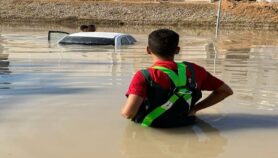Send to a friend
The details you provide on this page will not be used to send unsolicited email, and will not be sold to a 3rd party. See privacy policy.
The 8 October earthquake that killed more than 70,000 Pakistanis highlighted the urgent need for Pakistan to improve its ability to monitor seismic activity.
Large areas of Pakistan fall within the Himalayan arc, a region prone to movements of the tectonic plates covering the Earth’s surface. Yet, academics there say the authorities have so far paid little attention to the need to study and record earthquakes.
“Utterly unsatisfactory,” responds Iqbal Mohsin, vice-chancellor of the Federal Urdu University of Arts, Sciences and Technology (FUUAST), when asked to describe the country’s earthquake monitoring network. “We have just two seismology centres of any use in the country, which is totally inadequate.”
Seismology — the study of earthquakes — relies on highly sensitive instruments called seismometers that can measure vibrations caused by an earthquake.
“Pakistan should have at least fifty centres with seismometers, especially because we now know exactly how vulnerable we are to seismic activity,” says Mohsin. “Due to a shortage of seismometers there is scant data in the country on the subject.”
The October death toll, which is likely to increase as winter progresses in a region where many are now homeless and at the mercy of the freezing weather, has forced authorities to implement without delay a US$3.3 million plan to upgrade Pakistan’s seismic network.
 |
| The earthquake’s survivors faces shortages of food and shelter |
| Credit: US State Department |
The plan was drawn up after the 2004 Indian Ocean tsunami and was initially designed to create a system to warn of potential killer waves. In view of the recent quake in the north of the country, however, the plan’s implementation has been sped up.
When disaster struck on 8 October, the country had in place a very basic seismic network with just five permanent centres run by the Islamabad-based Pakistan Meteorology Department.
Of these only two — those in Quetta and in Peshawar — had seismometers recording data on a regular basis. Those in Islamabad, Karachi and Lahore did not.
Mohsin believes Karachi alone, with its 12 million inhabitants, needs five seismometers.
“Cities like Karachi are huge. We can easily have a situation in which one part of the city may be experiencing a quake while all others remain oblivious to it,” he explains. “Moreover, the soil may vary greatly within a megacity, and this has a big bearing on its vulnerability.”
But upgrading and increasing the amount of equipment will not be enough to ensure that the country is prepared for future earthquakes. Very few Pakistani universities impart training in geology or geophysics. Fewer still are involved in research.
Mohsin of FUUAST and Majeedullah Qadri, a professor of geology of Karachi University, agree that Pakistan has not undertaken meaningful research in the fields of seismology and geophysics since independence in 1947.
They claim the main reason for this is a lack of interest in research among bureaucrats and university faculties.
A division of the Karachi-based NED University of Engineering and Technology does publish a regular newsletter on seismology and geology, but that is the bulk of its activities in the area. Peshawar University started working in these disciplines less than a year ago.
According to Qadri, the Quaid-i-Azam University is the only one in the country able to award doctorates in the field.
 |
| Road damaged by the 8 October earthquake |
| Credit: USAID |
“Before the earthquake, nobody realised the importance of research in seismology or geology,” says Qadri. “This is why we have failed to produce a single well-known seismologist in our 58-year history. As a result, research in this area is practically non-existent.”
He points out that strengthening Pakistan’s ability to detect and monitor earthquakes will depend on training more young researchers.
“There is clearly a need for substantial research. But we cannot have good research until we start dealing with the issues in greater detail at the undergraduate as well as the postgraduate level.”
Qamar-uz-Zaman Chaudhary, director-general of the Pakistan Meteorology Department accepts that little seismological research has been done and that monitoring instruments need upgrading. “It is also true that our seismic network is not up to the mark,” he adds. “But all this is about to change.”
The government plan involves setting up a number of centres to record seismic activity and conduct related research.
Chaudhary says five seismometers have already been ordered and will be installed in various cities, including Karachi. In addition, a National Seismic Centre, which will act as a safeguard against tsunamis and earthquakes, is being built at his department’s campus in Karachi.
Mohsin, meanwhile, says his university also hopes to set up a seismology research centre and has asked the Higher Education Commission to acquire the services of reputable foreign experts.
“We have also asked the Higher Education Commission to procure seismometers for us. Similarly, we are asking the provincial government to give us a piece of land [to build the centre on].”
Both Mohsin and Chaudhary say that imparting proper training and education in seismology and undertaking research in the area is not just the responsibility of government-run research and education institutes.
They believe both public and private universities need to open new research centres where the two sectors can work together.
Click here to read more about science in Pakistan.












